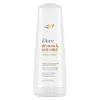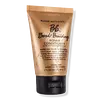What's inside
What's inside
 Key Ingredients
Key Ingredients

 Benefits
Benefits

 Concerns
Concerns

 Ingredients Side-by-side
Ingredients Side-by-side

Zinc Pyrithione 0.5%
AntiseborrhoeicWater
Skin ConditioningCetearyl Alcohol
EmollientCyclopentasiloxane
EmollientStearamidopropyl Dimethylamine
EmulsifyingDimethiconol
EmollientBehentrimonium Chloride
PreservativeCocos Nucifera Oil
MaskingButyrospermum Parkii Butter
Skin ConditioningTocopheryl Acetate
AntioxidantHelianthus Annuus Seed Oil
EmollientParfum
MaskingDipropylene Glycol
HumectantLactic Acid
BufferingDMDM Hydantoin
PreservativeZinc Sulfate
AntimicrobialSodium Chloride
MaskingTea-Dodecylbenzenesulfonate
CleansingGlycerin
HumectantButylene Glycol
HumectantIodopropynyl Butylcarbamate
PreservativePEG-150 Distearate
EmulsifyingZinc Pyrithione 0.5%, Water, Cetearyl Alcohol, Cyclopentasiloxane, Stearamidopropyl Dimethylamine, Dimethiconol, Behentrimonium Chloride, Cocos Nucifera Oil, Butyrospermum Parkii Butter, Tocopheryl Acetate, Helianthus Annuus Seed Oil, Parfum, Dipropylene Glycol, Lactic Acid, DMDM Hydantoin, Zinc Sulfate, Sodium Chloride, Tea-Dodecylbenzenesulfonate, Glycerin, Butylene Glycol, Iodopropynyl Butylcarbamate, PEG-150 Distearate
Water
Skin ConditioningCetearyl Alcohol
EmollientTricaprylyl Citrate
EmollientHeptyl Undecylenate
EmollientBehentrimonium Methosulfate
Stearamidopropyl Dimethylamine
EmulsifyingHoney
HumectantCocos Nucifera Oil
MaskingButyrospermum Parkii Butter
Skin ConditioningHydrogenated Castor Oil/Sebacic Acid Copolymer
EmollientLactic Acid
BufferingIsostearyl Ethylimidazolinium Ethosulfate
Hydroxypropylgluconamide
HumectantHydroxypropylammonium Gluconate
HumectantDistearyldimonium Chloride
Octyldodecyl Citrate Crosspolymer
HumectantButyl Methoxydibenzoylmethane
UV AbsorberEthylhexyl Methoxycinnamate
UV AbsorberPropanediol
SolventButylene Glycol
HumectantSimethicone
EmollientBenzyl Alcohol
PerfumingBHT
AntioxidantMalt Extract
Skin ProtectingYeast Extract
Skin ConditioningParfum
MaskingLinalool
PerfumingBenzyl Salicylate
PerfumingLimonene
PerfumingTartaric Acid
BufferingCaprylyl Glycol
EmollientCetrimonium Chloride
AntimicrobialPotassium Sorbate
PreservativePhenoxyethanol
PreservativeWater, Cetearyl Alcohol, Tricaprylyl Citrate, Heptyl Undecylenate, Behentrimonium Methosulfate, Stearamidopropyl Dimethylamine, Honey, Cocos Nucifera Oil, Butyrospermum Parkii Butter, Hydrogenated Castor Oil/Sebacic Acid Copolymer, Lactic Acid, Isostearyl Ethylimidazolinium Ethosulfate, Hydroxypropylgluconamide, Hydroxypropylammonium Gluconate, Distearyldimonium Chloride, Octyldodecyl Citrate Crosspolymer, Butyl Methoxydibenzoylmethane, Ethylhexyl Methoxycinnamate, Propanediol, Butylene Glycol, Simethicone, Benzyl Alcohol, BHT, Malt Extract, Yeast Extract, Parfum, Linalool, Benzyl Salicylate, Limonene, Tartaric Acid, Caprylyl Glycol, Cetrimonium Chloride, Potassium Sorbate, Phenoxyethanol
Ingredients Explained
These ingredients are found in both products.
Ingredients higher up in an ingredient list are typically present in a larger amount.
Butylene Glycol (or BG) is used within cosmetic products for a few different reasons:
Overall, Butylene Glycol is a safe and well-rounded ingredient that works well with other ingredients.
Though this ingredient works well with most skin types, some people with sensitive skin may experience a reaction such as allergic rashes, closed comedones, or itchiness.
Learn more about Butylene GlycolThis ingredient is also known as shea butter. It is an effective skin hydrator and emollient.
Emollients help soothe and soften your skin. It does this by creating a protective film on your skin. This barrier helps trap moisture and keeps your skin hydrated. Emollients may be effective at treating dry or itchy skin.
Shea butter is rich in antioxidants. Antioxidants help fight free-radicals, or molecules that may harm the body. It is also full of fatty acids including stearic acid and linoleic acid. These acids help replenish the skin and keep skin moisturized.
While Shea Butter has an SPF rating of about 3-4, it is not a sunscreen replacement.
Shea butter may not be fungal acne safe. We recommend speaking with a professional if you have any concerns.
Learn more about Butyrospermum Parkii ButterCetearyl alcohol is a mixture of two fatty alcohols: cetyl alcohol and stearyl alcohol. It is mainly used as an emulsifier. Emulsifiers help prevent the separation of oils and products. Due to its composition, it can also be used to thicken a product or help create foam.
Cetearyl alcohol is an emollient. Emollients help soothe and hydrate the skin by trapping moisture.
Studies show Cetearyl alcohol is non-toxic and non-irritating. The FDA allows products labeled "alcohol-free" to have fatty alcohols.
This ingredient is usually derived from plant oils such as palm, vegetable, or coconut oils. There is debate on whether this ingredient will cause acne.
Due to the fatty acid base, this ingredient may not be Malassezia folliculitis safe.
Learn more about Cetearyl AlcoholCocos Nucifera Oil is obtained from the kernels of the coconut fruit. In other words, this is coconut oil.
Coconut Oil is rich in fatty acids with lauric acid making up the majority of these. It also contains linoleic acid. Due to this high fatty acid content, coconut oil helps trap moisture and soften skin.
Despite being antibacterial, coconut oil may not be great for acne-prone skin. It is comedogenic and may clog pores. This ingredient may not be safe for malassezia or fungal acne.
Note: Coconut Oil should not replace your sunscreen for UV protection. Studies show it only blocks about 20% of UV.
This oil is non-volatile and has a light scent.
The term 'fragrance' is not regulated in many countries. In many cases, it is up to the brand to define this term. For instance, many brands choose to label themselves as "fragrance-free" because they are not using synthetic fragrances. However, their products may still contain ingredients such as essential oils that are considered a fragrance.
Learn more about Cocos Nucifera OilLactic Acid is another well-loved alpha hydroxy acid (AHA). It is gentler than glycolic acid but still highly effective.
Its main role is to exfoliate the surface of the skin by loosening the “glue” that holds dead skin cells together. Shedding those old cells leads to smoother, softer, and more even-toned skin.
Because lactic acid molecules are larger than glycolic acid, they don’t penetrate as deeply. This means they’re less likely to sting or irritate, making it a great choice for beginners or those with sensitive skin.
Like glycolic acid, it can:
Lactic acid also acts as a humectant (like hyaluronic acid). It can draw water into the skin to improve hydration and also plays a role in the skin's natural moisturizing factor (NMF) in the form of sodium lactate.
Studies show it can boost ceramide production to strengthen the skin barrier and even help balance the skin’s microbiome.
To get results, choose products with a pH between 3-4.
Lower strengths (5-12%) focus on surface exfoliation; higher strengths (12% and up) can reach deeper in the dermis (deeper, supportive layer) to improve skin texture and firmness over time.
Though it was originally derived from milk, most modern lactic acid used in skincare is vegan. It is made through non-dairy fermentation to create a bio-identical and stable form suitable for all formulations.
When lactic acid shows up near the end of an ingredient list, it usually means the brand added just a tiny amount to adjust the product’s pH.
Legend has it that Cleopatra used to bathe in sour milk to help reduce wrinkles.
Lactic acid is truly a gentle multitasker: it exfoliates, hydrates, strengthens, and brightens. It's a great ingredient for giving your skin a smooth, glowing, and healthy look without the harshness of stronger acids.
Read more about some other popular AHA's here:
Learn more about Lactic AcidParfum is a catch-all term for an ingredient or more that is used to give a scent to products.
Also called "fragrance", this ingredient can be a blend of hundreds of chemicals or plant oils. This means every product with "fragrance" or "parfum" in the ingredients list is a different mixture.
For instance, Habanolide is a proprietary trade name for a specific aroma chemical. When used as a fragrance ingredient in cosmetics, most aroma chemicals fall under the broad labeling category of “FRAGRANCE” or “PARFUM” according to EU and US regulations.
The term 'parfum' or 'fragrance' is not regulated in many countries. In many cases, it is up to the brand to define this term.
For instance, many brands choose to label themselves as "fragrance-free" because they are not using synthetic fragrances. However, their products may still contain ingredients such as essential oils that are considered a fragrance by INCI standards.
One example is Calendula flower extract. Calendula is an essential oil that still imparts a scent or 'fragrance'.
Depending on the blend, the ingredients in the mixture can cause allergies and sensitivities on the skin. Some ingredients that are known EU allergens include linalool and citronellol.
Parfum can also be used to mask or cover an unpleasant scent.
The bottom line is: not all fragrances/parfum/ingredients are created equally. If you are worried about fragrances, we recommend taking a closer look at an ingredient. And of course, we always recommend speaking with a professional.
Learn more about ParfumWe don't have a description for Stearamidopropyl Dimethylamine yet.
Water. It's the most common cosmetic ingredient of all. You'll usually see it at the top of ingredient lists, meaning that it makes up the largest part of the product.
So why is it so popular? Water most often acts as a solvent - this means that it helps dissolve other ingredients into the formulation.
You'll also recognize water as that liquid we all need to stay alive. If you see this, drink a glass of water. Stay hydrated!
Learn more about Water